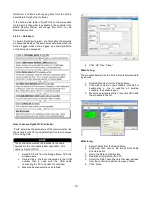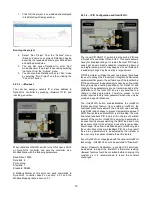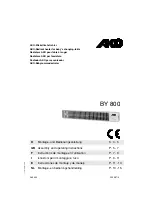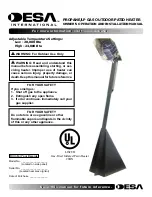
5
caused by lack of cleaning and maintenance of the heat
exchanger. This appliance is equipped with victaulics on all
connection points to the heat exchanger for easy removal
of the heat exchanger for maintenance and cleaning.
3.2
– Double Wall Models
The design of the double wall brazed plate heat exchanger
prevents cross contamination of fluid streams if there is an
internal leak within the fluid. Two stainless steel plate walls
separate the fluid streams, with an air gap in between. In
the event of a leak, the affected fluid will flow in the air gap
and escape out of the heat exchanger, enabling visual
detection of the leak.
The double-wall models are designed to minimize the risk
of cross contamination by allowing for visual notice of
internal leak(s)
– prompting the user to take action before
the issue propagates. In the event that a failure is left
undetected, and the product not promptly removed from
service, the structural integrity of the product may become
compromised, resulting in further damage to the product.
The user is responsible for systematic and periodic
monitoring of the product to detect potential leaks
–
failure to do so defeats the purpose of the double-wall
design.
3.3
– Cleaning
As previously mentioned, the heat exchangers used in all
DynaFLO models have special corrugation patterns that
promote turbulent flow. As a result, the heat exchangers
operate with high turbulence flow, even at low flow rates.
This high turbulence keeps small particles in suspension
minimizing fouling and scaling. However, in some
applications the fouling tendency can be very high (e.g.
using extremely hard water at high temperatures). In such
cases, it is always possible to clean the heat exchanger by
circulating a cleaning liquid. All DynaFLO models are
equipped with Victaulics right downstream of each heat
exchanger inlet and outlet connection. The Victaulics allow
for easy removal of the heat exchanger for cleaning:
1. Before shutting off the unit close the portion of the
boiler loop leading to the boiler side of the
DynaFLO while letting the domestic side run for 5
to 10 minutes. This will cause the cold domestic
supply to take away any heat left on the boiler side
before shutting down.
2. Once the heat exchanger has cooled down, close
down the domestic supply to DynaFLO.
3. Turn off the DynaFLO by switching the power
button.
4. Drain the unit by using the drain valves provided
on DynaFLO.
5. Remove the Victaulics.
6. Remove the heat exchanger shroud
7. Slowly remove the heat exchanger while sliding it
on the built-in stool inside the heat exchanger
cabinet.
8. Use a tank with a descaling solution that is safe for
domestic water applications and is compatible with
stainless steel, copper, brass and bronze.
9. Pump the cleaning liquid through the heat
exchanger. For optimum cleaning, the cleaning
solution flow rate should be a minimum of 1.5
times the normal flow rate, or as per the table
below, preferably in a back-flush mode.
Recommended Flow for Effective Back-Flush Mode
Model
Flow (GPM)
Single Wall
DOWB-S1-
19
DOWB-S2-
20
DOWB-S3-
38
DOWB-S4-
46
DOWB-S5-
53
DOWB-S6-
59
Double Wall
DOWB-D1-
12
DOWB-D2-
25
DOWB-D3-
31
DOWB-D4-
43
DOWB-D5-
54
DOWB-D6-
63
Note: Flow can deviate from the nominal value on the table
10. After use, do not forget to rinse the heat exchanger
carefully with clean water.
11. Only use chemicals which do not attack copper
and stainless steel. Consult a cleaning specialist
in case of doubt.
Part 4
– Electrical
4.1
– Overview
***See Electrical Schematics in Appendix B***
The appliance, when installed, must be electrically
grounded in accordance with the requirements of the
authority having jurisdiction or in the absence of such
requirements, with the latest edition of the National
Electrical Code ANSI/NFPA No. 70. When the unit is
installed in Canada, it must conform to the Canadian
Electrical Code, C22.1, Part 1 and/or local Electrical Codes.
All wiring between the appliance and field installed devices
shall be made with wire having minimum 220ºF (105ºC)
rating. Line voltage wire external to the appliance must be
enclosed in approved conduit or approved metal clad cable.
To avoid serious damage,
DO NOT ENERGIZE
the
appliance until the pipes are full of water. Ensure that all air
is removed from the pump housing and piping before
beginning initial operation. Provide the appliance with
proper overload protection.
WARNING
THIS PRODUCT MUST BE PROPERLY GROUNDED
BEFORE ANY ELECTRIC CURRENT IS APPLIED TO
THE BLOWER OR CONTROLS!









































